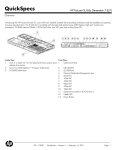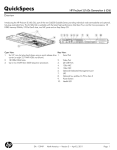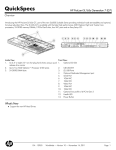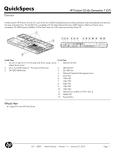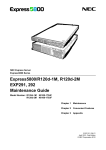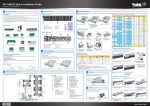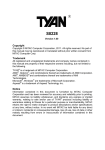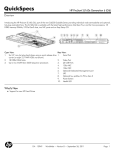Download HP ProLiant SL165s G7 Server Installation Instructions
Transcript
HP ProLiant SL165s G7 Server Installation Instructions Part Number 635251-002 Identifying server components Front panel components SL165s G7 Server Front Panel Components Figure 1 Front panel components of the s6500 chassis with 4 SL165s G7 servers 2 Item Description 1 UID LED/Switch 2 Serial port 3 Top: NIC4 Connector Bottom: NIC3 Connector 4 Server 1 5 Server 2 6 Server 3 7 Power LED/Switch 8 Health LED 9 NIC1 Connector 10 NIC2 Connector 11 Server 4 12 VGA port 13 Mgmt NIC (Optional) 14 Top: USB 2.0 Port Bottom: USB 2.0 Port 15 SD card slot (Optional) Rear Panel Components System Board Components Figure 2 Rear panel components of the s6500 chassis with 4 SL165s G7 servers Figure 3 System Board Components Item Designator Description 1 J1 System maintenance jumper 2 J301 PCIe x16 slot 3 U1 Processor 1 4 J11 Mgmt card connector Power Supply 2 5 J110 DIMM slot 12 for processor 1 5 Power Supply 3 6 J103 DIMM slot 1 for processor 1 6 Fan 2 7 J210 DIMM slot 12 for processor 2 7 Fan 1 8 U2 Processor 2 8 Fan 3 9 J54 4-pin power connector 9 Fan 4 10 J52 24-pin power connector 10 Power Blank 11 J61 Fan connector 1 11 Chassis UID 12 J62 Fan connector 2 12 SLAPM (SL Advanced Power Manager) connector 13 J203 DIMM slot 1 for processor 2 13 Fan 7 14 J68 Backplane I2C connector 14 Fan 8 15 J53 8-pin power connector 16 J63, J64 Fan connectors 3/4 17 J65 Fan connector 5 18 J49 Internal USB 2.0 port 19 J8 Front panel USB 2.0 port 20 J81 SD card USB 2.0 port 21 J100 SAS LED connector 22 J66, J69 Fan connectors 6/7 23 J55 Power backplane control connector 24 J13 Mini-SAS connector for SATA 25 J98 Front panel header 26 J56 TPM connector 27 J78 PCIe x4 slot 28 J23 ODD 1 SATA connector 29 J20 ODD 2 SATA connector 30 BH1 3V CMOS battery (CR2032) 31 J6 NMI jumper Item Description 1 Fan 6 2 Fan 5 3 Power Supply 1 4 3 Server Configuration Resources In addition to this Installation Sheet, other resources are available for more information regarding the configuration and maintenance of your server: • • • • 5. Connect all external cables to the system. 6. Press the power button on the front panel to turn on the server. Removing the Tray For safety information and detailed procedures relating to installation of options, refer to any installation instructions that came with the option, as well as the HP ProLiant SL165s G7 Server Maintenance and Service Guide. You need to remove the tray from the chassis before you can remove or replace a tray component. To remove the tray: For safety information, regulatory notices, and detailed procedures related to the rest of the steps listed in the “Configuring the Server” section, refer to relevant chapter of the HP ProLiant SL6000/6500 Scalable System User Guide. For information relating to system BIOS configuration and operating system installation, refer to relevant section of the HP ProLiant SL165s G7 Server Software Configuration Guide. You can also access additional information and documentation from the HP website at http://www.hp.com/servers/proliantsl165s. 1. Press the two handles on both sides at the same time to release the tray. 2. Pull out the tray from the chassis until the release latch catches. 3. Firmly holding the tray, press the release latch on both sides of the tray. 4. Remove the tray from the chassis. Figure 4 Removing the SL165s G7 server tray Server Configuration Overview The steps listed below give an overview of the necessary setup procedures for preparing the HP ProLiant SL165s G7 Server for operation: 1. Connect the AC power cord and peripheral devices. 2. Power up the server. 3. Press “F10” to enter BIOS setup. 4. Note the server BIOS version. 5. Verify the server BIOS version against the latest BIOS version listed for this server on the HP website: http://www.hp.com. 6. If you do not have the latest BIOS, update the BIOS now. Refer to the HP ProLiant SL165s G7 Server Maintenance and Service Guide available on the HP website: http://www.hp.com. 7. Install a supported operating system of your choice. For detailed procedures, refer to the documentation provided by the operating system vendor. For a list of operating systems supported by your ProLiant server, go to http://www.hp.com/go/supportos. Figure 5 Installing the SL165s G7 server tray Pre- and Post-installation Procedures When installing additional options in your HP ProLiant SL165s G7 Server, observe the following procedures: Pre-installation procedures 1. Turn off the server and all the peripherals connected to it. 2. Remove the tray from the chassis by following the procedure described later in the “Removing the tray” section. Installing the Hard Disk Drive Post-installation procedures 1. Be sure all components are installed according to the described step-by-step instructions. 2. Check to make sure you have not left loose tools or parts inside the server. 3. Reinstall the PCI riser, peripherals, and system cables that you have removed. 4. Reinstall the tray into the chassis. One SL165s G7 server tray can accommodate up to 6 LFF SATA, 4 LFF SAS, or 8 SFF SATA/SAS Non Hot-Plug hard disk drives, and the chassis can accommodate 4 server trays for up to 24 LFF SATA or 32 SFF Non Hot-Plug hard disk drives. The server supports both SAS and SATA hard disk drives. 4 NOTE: NOTE: For specific supported hard drive configurations and cable routing, refer to HP ProLiant SL165s G7 Server Maintenance and Service Guide located on the HP website: http://www.hp.com/support/ProLiant_SL165sG7_MSG_en SR = Single Rank, DR = Dual Rank, QR = Quad Rank. Population rules must be followed for both processors. Memory modules may be populated one at a time per processor, but populating two at a time per processor provides better performance. CAUTION: Drives can be damaged by static electricity. Before handling drives, touch an unpainted metal surface to discharge static electricity. Memory modules should be populated four at a time per processor for best performance. To install the LFF hard disk drive in the server tray: Quad Rank memory module can only be installed in memory sockets 2, 5, 8, and 11. 1. Unlock the HDD carrier latches. 2. Lift the HDD carrier handle up. 3. Insert the HDD carrier and align the pins. 4. Press the HDD carrier handle down. 5. Lock the HDD carrier latches. CAUTION: DIMMs can be damaged by improper handling. Always use an anti-static wrist strap and grounding mat, and discharge static electricity before touching DIMMs. Figure 6 Installing the hard disk drive To install a memory module: 1. Align the notch on the bottom edge of the module with the keyed surface of the DIMM slot and then press the module fully into the slot. 2. Firmly press the holding clips inward to secure the memory module in place. Figure 7 Installing the memory module Installing the Memory Module Memory Module Population Order (From left to right) RDIMM population order without QR DIMM Memory Socket 1 7 4 10 3 9 6 12 2 8 5 11 X X X 6 12 DIMM slots are structured to ensure proper installation. If you insert a DIMM but it does not fit easily into the slot, you may have inserted it incorrectly. Reverse the orientation of the DIMM and insert it again. UDIMM population order without QR DIMM Memory Socket 1 7 4 10 3 9 6 12 X Population order with QR along with SR/DR DIMM Memory Socket 2 8 5 11 1 7 4 10 3 9 5 Installing the Processor To install the new processor: 1. Insert the processor in the tool. 2. Align the processor installation tool with the socket and install the processor. 1. Properly align the heat sink mounting pins to the system board mounting holes. 2. Tighten the mounting pins clockwise to secure the heat sink connection to the system board. CAUTION: To prevent the heat sink from tilting to one side during installation/removal, turn each screw a couple of turns, alternatively between both of them, and then apply the final torque. Do not over tighten the spring loaded screws to prevent them from breaking off. A maximum torque of 4.5 inch-lb is set for each screw. Figure 8 Installing the processor Figure 10 CPU 1 installing the heat sink with 17 fin pitches IMPORTANT: Be sure the processor remains inside the processor installation tool. 1. Press down firmly until the processor installation tool clicks and separates from the processor, and then remove the processor installation tool. 2. Close the processor socket retaining bracket and the processor retaining latch Figure 11 CPU 2 installing the heat sink with 38 fin pitches Figure 9 Removing the processor installation tool and close the processor socket CAUTION: Be sure that the heat sink sits squarely on the processor, or overheating and damage to the processor may occur. IMPORTANT: If the heat sink has been removed for any reason, it is critical that you apply more thermal interface material to the integrated heat spreader on the processor to ensure proper thermal bonding between the processor and the heat sink. Clean the contact surface of both the processor and heat sink with an alcohol pad, then re-apply an HP-approved thermal interface material before reinstalling the processor. Use a pattern of five dots when applying the thermal interface material—one dot in the center, and one dot at each corner. For processor removal, reverse the above installation procedures. To install the heat sink: IMPORTANT: The one close to front panel is processor 1 and the other one is processor 2. During install the heat sink, make sure to install heat sink 1(on the processor 1) with 17 fin pitches, while heat sink 2(on the processor 2) with 38 fin pitches. 6 Figure 13 Installing the CPU air baffle into the tray NOTE: Do not over tighten the heat sink’s spring-loaded screws to prevent them from breaking off. Installing the DIMM Air Baffle NOTE: The DIMM air baffle is required for proper thermal solution. 1. Hold the latch on the top of the DIMM air baffle and align it to the system board. 2. Press down to make sure the DIMM air baffle completely installed NOTE: To check and ensure the 2 ribs are installed between DIMM1 and DIMM2, DIMM11 and DIMM12. Figure 12 Installing the DIMM air baffle into the tray Additional Documentation For additional documentation, refer to HP ProLiant SL165s G7 Server Easy Set-up CD. You can also access additional information and documentation from the HP external website, either by connecting directly or through the Easy Set-up CD. Installing the CPU Air Baffle NOTE: The CPU air baffle is required for proper thermal solution. To install the CPU air baffle: 1. Align the CPU air baffle to the tray. 2. Secure the left latch to the left bracket, the middle latch to the middle bracket and the right latch to the PCIe x16 bracket on the tray. 3. Press down the CPU air baffle to make sure it completely installed on the tray. 7 Legal notices © Copyright 2010, 2011 Hewlett-Packard Development Company, L.P. The information contained herein is subject to change without notice. The only warranties for HP products and services are set forth in the express warranty statements accompanying such products and services. Nothing herein should be construed as constituting an additional warranty. HP shall not be liable for technical or editorial errors or omissions contained herein. Part Number 635251-002 February 2011 (Second Edition) Printed in China *635251-002* 635251-002








